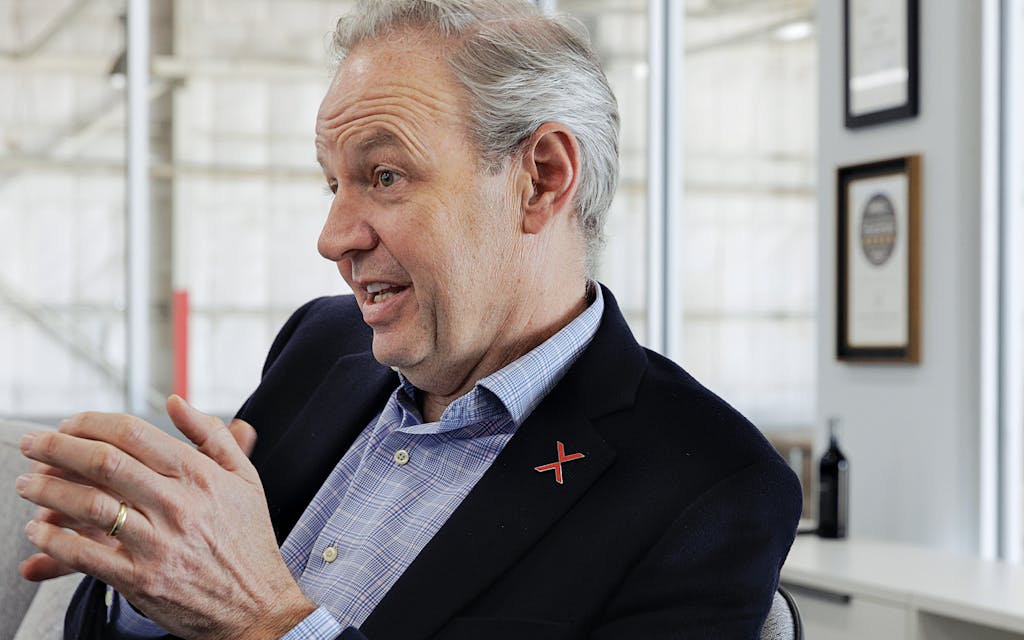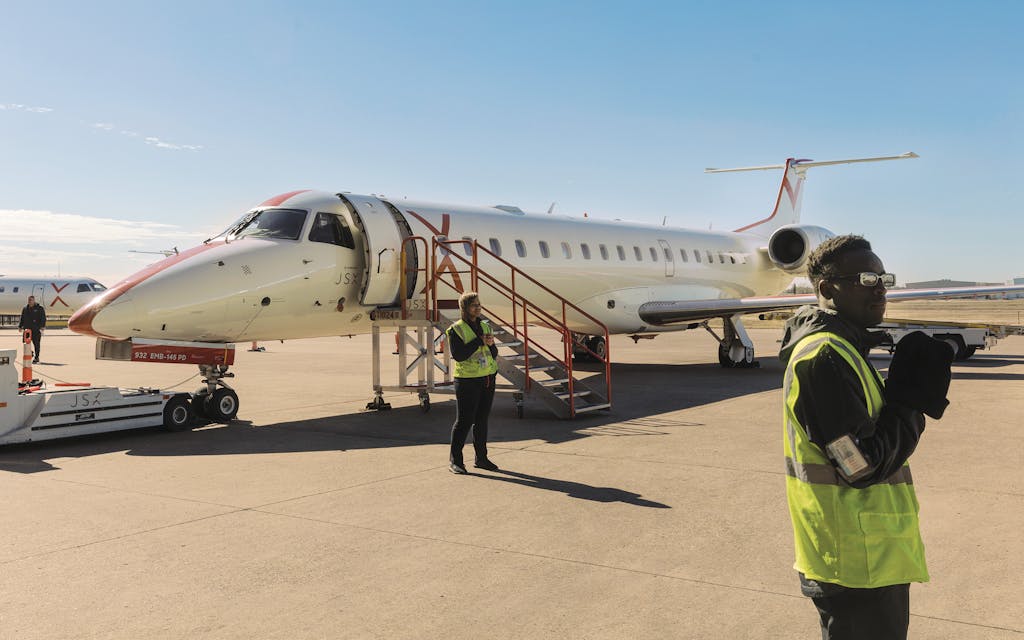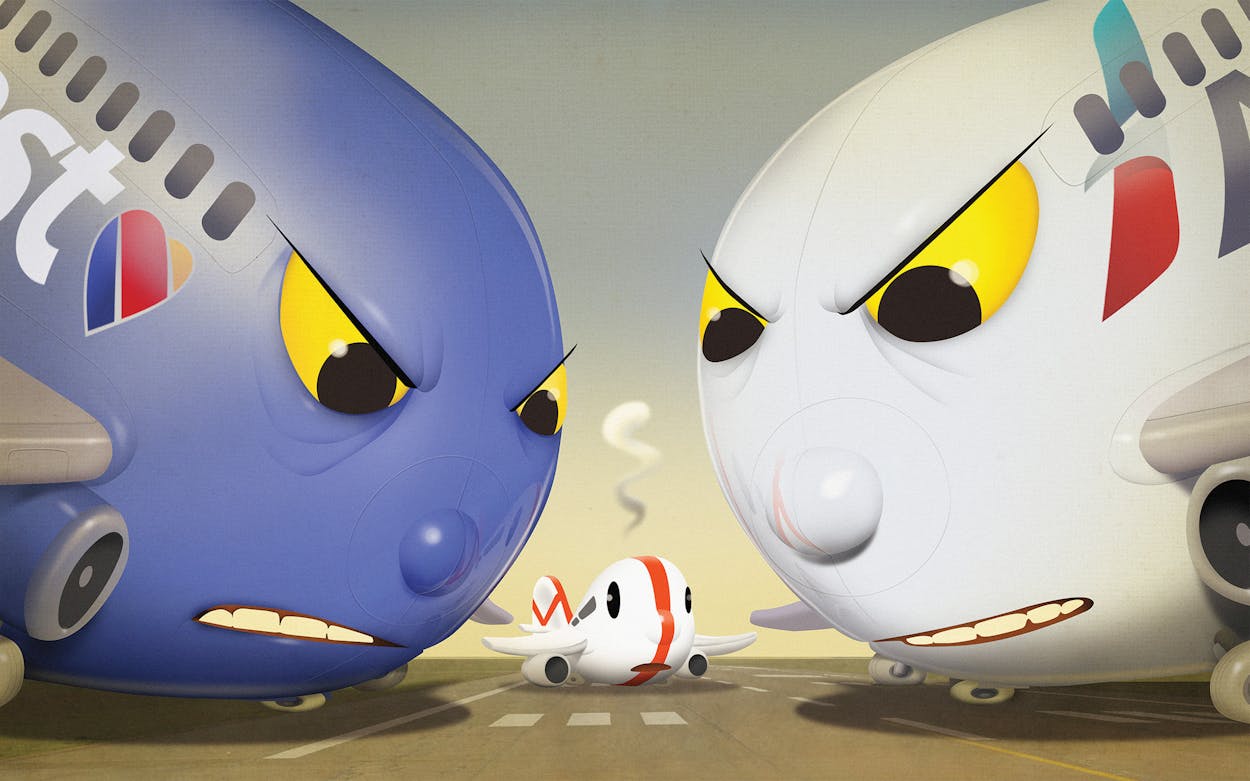Minutes before boarding begins for a flight from Dallas to Houston, it’s library quiet inside the terminal. No testy TSA agents yell out instructions. No overhead announcements drone on endlessly about limited overhead space. The loudest noise is the click-clack of a flight attendant’s heels on the concrete floor as she walks by two dozen passengers reclining on cushy couches and chairs.
It’s so serene that even Alex Wilcox, CEO of the airline, seems surprised that a departure is imminent. “Oh, I guess people are checking in,” he says as a couple rolls bags past him. They’ve just dropped off their car keys at the valet outside the private hangar at Love Field.
All this calm comes at a cost. The airline, Dallas-based JSX, charges business-class fares for its flights on small thirty-seat jets. Its passengers enjoy plentiful legroom, free checked bags, free snacks, and free booze. They also save time. Because there are no X-ray machines scanning every piece of luggage, few restrictions on carrying liquids on board, and no need to remove belts and shoes, JSX passengers can show up as little as twenty minutes before departure.
Its customers may love that deal, but JSX’s Love Field neighbor, Southwest Airlines, as well as Fort Worth–based American Airlines, hate it. The major carriers contend that JSX’s operations are unsafe, even though it has not recorded a serious safety incident since it started flying, in 2016. Last year, American, Southwest, and multiple airline-pilot unions launched a lobbying attack in Washington. The Federal Aviation Administration subsequently said it will consider rewriting decades-old regulations, a move that could put JSX out of business.
Wilcox literally grits his teeth when discussing the complaints about his airline. “This is completely unfounded,” says the tall, lean, gray-haired 55-year-old. “No one has ever pointed to any piece of evidence that says we’re somehow riskier.”
JSX’s fleet numbers 48 jets, tiny compared with those of Southwest and American, with nearly 1,000 planes each, but the upstart isn’t entirely outgunned in the FAA fight. JetBlue and United Airlines have invested in JSX, and its flights let passengers accrue miles in the loyalty programs of those larger carriers. JSX plans to leverage those partnerships by expanding to potentially hundreds of airports. That is if the feds don’t cave to pressure from American and Southwest and ground JSX.
For now Wilcox has defiantly dug in for what may be a long battle. “This,” he says, “is all about a couple of lobbyists taking people out to dinner in Washington, D.C., and saying, ‘Hey, you’ve got to snuff out our competition because we’re too stupid to figure out how to do this ourselves.’ ”
Quiet persists inside the JSX flight-operations center at Love Field too. All the overhead lights are off in the dark, windowless space, which is arranged like a college lecture hall, with a dozen rows of auditorium-style tables. Only about a half dozen JSX employees are present, illuminated by the laptops they’re staring into.
In the well at the front of the room, two large wall-mounted monitors display live feeds from cameras at several airports around the country as well as a listing of the current positions of JSX’s jets. The fleet operates at 21 airports in nine states, from California to New York, as well as Cabo San Lucas, Mexico. In Texas it flies to Love Field, Houston Hobby, Austin Executive, and Lajitas International, an airstrip at a golf resort near Terlingua.

Wilcox looks up at the big screen and points to a plane whose tail number is highlighted in red. “This one is in Vegas,” he says. It had flown for United Express before being retired to a storage facility in the Arizona desert. JSX bought the jet in 2022, ripped out its sixteen rows of fifty cloth-upholstered seats, and installed just fifteen rows with thirty leather-clad seats. That extra comfort costs money, which is why JSX markets to a well-heeled audience.
“Our customer is admittedly an affluent individual,” Wilcox says. “We do have to charge more because we have fewer seats on the airplane. We charge a hell of a lot less than [private-jet operator] NetJets, but we charge a little bit more than Southwest.” When I checked JSX’s fares against Southwest’s on the same date for a Dallas-to-Houston round trip earlier this year, Southwest’s cheapest ticket cost $582 while JSX’s cost $708.
Wilcox, who grew up in Vermont and earned his pilot’s license at age seventeen, has spent his entire career in aviation, including as one of the founding executives of JetBlue. In 1992, while a student at the University of Vermont, he landed an internship with Southwest’s communications department. Southwest didn’t fly anywhere near Vermont back then, but the company’s rapid growth and fun-loving culture had caught his attention.
During his summer at Southwest’s Love Field headquarters, he became enamored of smoked brisket, fried okra, and the airline’s legendary chain-smoking cofounder Herb Kelleher. Wilcox’s tasks included driving the notoriously messy Kelleher around in the CEO’s “disgusting, cigarette-smelling Lexus,” he says. (Wilcox remains so awed by Kelleher, who died in 2019, that JSX offers Kelleher’s favorite whiskey—101-proof Wild Turkey—on its flights.)
His internship also required clipping newspaper articles about Southwest and distributing them to executives. From those stories he learned how the airline, in its early days, exploited a regulatory loophole to launch a new model of service in Texas. The two carriers then dominant in the state, Braniff and Texas International, pleaded with courts, lawmakers, and regulators to put Southwest out of business. “That’s a very inspiring story for us,” Wilcox tells me. JSX is “now in the position Southwest used to be in. We’re the underdog. We’re the ones who are being accused of operating under a loophole. And we’re the ones who customers actually love.”
Southwest, which declined to make an executive available for an interview, has been cautious in its public pronouncements about JSX. In a written statement to Texas Monthly, Southwest said it “supports the position” of the unions that have spoken out against JSX and expects the federal government to “hold all airlines to the same high standards for safety and security.”

Unless the FAA changes its rules, JSX won’t be required to meet the same standards as American and Southwest. The regulatory “loophole”—Wilcox bristles at the word—JSX stands accused of exploiting allows it to operate out of private air terminals and hire pilots who have logged fewer flying hours than the minimum required at major carriers. Using less experienced, lower-paid pilots reduces costs for JSX (to the dismay of pilots unions). But the private terminals represent the bigger competitive advantage because of the time savings they offer passengers.
Wilcox learned just how greatly passengers value time back in 2008, when he launched an air-charter service, eventually called JetSuite, that charged sky-high prices for short flights in nine-seat jets. Customers of the California company ponied up as much as $7,000 for a 45-minute trip from Orange County to Oakland, in large part to avoid the ordeal of parking and going through security for a typical commercial flight. That gave Wilcox an idea.
“I thought, ‘Boy, if we can offer that kind of convenience at a more consumer-friendly price point, we could really have something,’ ” he says. To do that, he needed to fly planes with more seats. Wilcox wasn’t sure that was permitted under federal rules, until he spent two weeks of mostly sleepless nights poring over the regulations. What he found put him on a collision course with two of the world’s biggest airlines.
Commercial airlines are divided into two groups by the Code of Federal Regulations. American and Southwest are known as Part 121 carriers, after the section of the rules that applies to them. Such carriers are allowed to set a flight schedule and sell tickets based on that schedule. The other group, Part 135 carriers, mainly operate “on demand,” meaning that you charter their services—for instance, when you want to fly private to the Super Bowl. But Part 135 carriers can also sell tickets to scheduled flights as long as the planes carry no more than nine passengers.
When Wilcox dug into the code in 2014, he found an exception that allowed Part 135 carriers to fly jet aircraft with as many as thirty seats. To do that, Wilcox had to create two separate companies. One, JSX Inc., is designated as a “public charter” that’s allowed to create a full flight schedule and sell tickets. But JSX Inc. must hire a second company, JSX Air, to fly the thirty-seat planes. Wilcox is CEO of both and moved their headquarters to Dallas, in 2018, because of the city’s central U.S. location and sizable aviation-industry talent pool.
American and Southwest and the pilots unions believe JSX’s hybrid structure is taking advantage of a loophole. “But it’s not really a loophole,” says Kent Jackson, the managing partner of JetLaw, an aviation law firm in Washington, D.C. “It was designed into the regulations twenty-five years ago.”
Safety concerns after a series of fatal crashes led to a 1997 code update. Until that year, some regional carriers that fly under brands such as American Eagle and United Express had mostly operated under Part 135 rules, which allow carriers to hire copilots with as few as 500 hours of experience in the cockpit. But regulators redesignated these carriers as Part 121 airlines, whose pilots and copilots both must have at least 1,500 flying hours. Fearing that the higher costs involved with this change would make flying to small, underserved markets untenable, the feds also crafted the rules, including the thirty-seat limit, under which JSX operates.
JSX does fly to small markets, albeit places that attract affluent customers, such as Gunnison, Colorado, a resort town popular with skiers and fly-fishing enthusiasts. JSX began offering service between Dallas and Gunnison, about a three-and-a-half-hour drive southwest of Denver, in 2022. “It has been a game changer,” says Jim Jose, a Texas Tech University grad and senior associate in the Crested Butte office—about thirty miles north of Gunnison—of SHM Architects.
American and United fly between Gunnison and Dallas Fort Worth International Airport, but Jose prefers the convenience of JSX’s private terminal and its location at Love Field, which sits just twenty minutes from his firm’s Dallas headquarters. On JSX, he says, he reaches Dallas “in an hour and forty-five minutes, and I’m able to get right into the office and do some work.”

Passengers such as Jose are saving time in part because they’re able to avoid being delayed by the TSA lines in public airport terminals. But skipping such security measures is, American and Southwest and the pilots unions argue, a danger to passengers and crews alike.
Two American executives I interviewed—both of whom asked not to be named—fretted over the risks of JSX’s safety practices, in which checked bags are not X-rayed and carry-ons can contain larger volumes of liquid than the TSA allows. Wilcox brushes off such concerns.
“It’s not about us having no security,” he says as he leads me through a metal detector inside JSX’s Love Field hangar. “It’s about having a different kind of security.” In flight, JSX’s bulletproof cockpit doors are locked. Before the flight, the TSA checks each booked JSX passenger against its no-fly list. JSX employees also swab every bag, including small carry-ons, for traces of explosives. Larger bags, even those that would typically fit in an overhead bin (which JSX aircraft do not have), are checked at the gate and delivered planeside on arrival.
JSX passengers must walk through a scanner made by California-based Evolv Technology. The machine uses electromagnetic sensors to screen for dangerous chemicals and anything shaped like a weapon, including 3D-printed guns. Evolv faced criticism last year when a report revealed its system missed 42 percent of large knives; the sensors failed to detect a hunting knife a student used to stab a classmate at a school in Utica, New York. But TSA checkpoints haven’t proved perfect either. In 2015 agents failed to catch 67 out of 70 dangerous devices intentionally smuggled into the terminal by inspectors for the U.S. Department of Homeland Security. Further testing, in 2017, produced similarly poor results. The TSA has changed its training procedures since then, but in 2020 the U.S. Government Accountability Office criticized the TSA for failing to make public any data about whether its screeners have improved.
American Airlines argues that if other Part 135 airlines copy JSX’s model, the public safety risks could expand significantly. (In 2022 the Utah-based airline SkyWest proposed to set up a JSX-style subsidiary, albeit a lower-cost one.) JSX “is small right now,” one of the American executives told me, but a future JSX could compete with American if the FAA, whose regulatory review could take several years, allows JSX to continue operating under different standards. “They have grown exponentially in a very small amount of time,” the executive says.
Wilcox is happy to confirm JSX’s ambitions to grow. Inside the airline’s headquarters, at Love Field, he takes me to a conference room overlooking a hangar where an Embraer 145 jet is parked. “That airplane right there can fly to any airport that has five thousand feet of runway,” he says. “There are over two thousand airports in the United States that have five thousand feet of runway. And as long as you fly that airplane with no more than thirty seats in it, you can fly to them all.” Conversely, because of FAA restrictions, American, Southwest, and other carriers with planes far exceeding thirty seats can fly to only about five hundred U.S. airports.
JSX has already revealed what future expansion might look like, to destinations including Mason City, Iowa; Cody, Wyoming; and King County International, near Seattle. It’s also eyeing destinations throughout Texas—Amarillo, Bryan–College Station, Del Rio, Lubbock, Victoria, and Fort Worth Meacham International Airport, some twenty miles from DFW and American’s headquarters.
JSX hasn’t announced a timetable for that growth, but even when it happens, Wilcox says, the major carriers don’t need to worry about his airline’s premium-passenger model, because it is so different from theirs. “It’s a joke,” he says. “We are not a threat to American.” He shrugs and adds, “But maybe they’re trying to kill us in our infancy.”
Joseph Guinto is a freelance writer and editor based in Washington, D.C.
This article originally appeared in the April 2024 issue of Texas Monthly with the headline “The Upstart Versus the Airline Bullies.” Subscribe today.
- More About:
- Business
- Fort Worth
- Dallas







